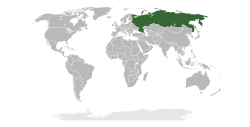Russia and weapons of mass destruction
|
Soviet Union Russian Federation |
|
|---|---|
 |
|
| Nuclear program start date | 1943 |
| First nuclear weapon test | August 29, 1949 |
| First fusion weapon test | August 12, 1953 |
| Last nuclear test | October 24, 1990 |
| Largest yield test | 58 Mt (240 PJ) (October 30, 1961) |
| Total tests | 715 detonations |
| Peak stockpile | 45,000 warheads (1988) |
| Current stockpile (usable and not) | 4,500 |
| Current strategic arsenal | 2,600 |
| Cumulative strategic arsenal in megatonnage |
663.5-801.5 (2016.est) (Variability occurs because of uncertainty about SS-18 yields) |
| Maximum missile range | Intercontinental up to 16,000 kilometers |
| NPT party | Yes (1968, one of five recognized powers) |
According to the Federation of American Scientists, an organization that assesses nuclear weapon stockpiles, as of 2016, Russian Federation possesses 7,300 total nuclear warheads, of which 1,790 are strategically operational. This is in large part due to the special bomber counting rules allowed by the treaty which counts each strategic nuclear bomber as one warhead irrespective of the number of warheads—gravity bombs and/or cruise missiles carried by the aircraft. The figures are, by necessity, only estimates because "the exact number of nuclear weapons in each country's possession is a closely held national secret." In addition to nuclear weapons, Russia declared an arsenal of 39,967 tons of chemical weapons in 1997, of which 57% have been destroyed. The Soviet Union ratified the on April 5, 1928 with reservations. The reservations were later dropped on January 18, 2001. Russia is also party to the Biological Weapons Convention and the Chemical Weapons Convention. The Soviet Union had a peak stockpile of 45,000 nuclear warheads in 1988. It is estimated that from 1949 to 1991 the Soviet Union produced approximately 55,000 nuclear warheads.
At the dissolution of the Soviet Union in 1991, Soviet nuclear weapons were deployed in four of the new republics: Russia, Ukraine, Belarus and Kazakhstan. In May 1992, these four states signed the , agreeing to join the Treaty on the Non-Proliferation of Nuclear Weapons, with Russia the successor to the Soviet Union as a nuclear state, and the other three states joining as non-nuclear states.
Ukraine agreed to give up its weapons to Russia, in exchange for guarantees of Ukrainian territory from Russia, the UK and the USA, known as the Budapest Memorandum on Security Assurances. China and France also made statements in support of the memorandum.
The exact number of nuclear warheads is a state secret and is therefore a matter of guesswork. The Federation of American Scientists estimates that Russia possesses 4,490 nuclear warheads, while the U.S. has 4,500; Russia has 1,790 active strategic nuclear warheads, compared with the U.S. having 1,750. According to 2016 data from the New START Treaty Aggregate Numbers of Strategic Offensive Arms facts sheet, the United States has fewer operationally deployed strategic warheads than Russia. On the other hand, Russia is estimated to have roughly 1,500 tactical nuclear weapons, all of which are declared to be in central storage.
...
Wikipedia
